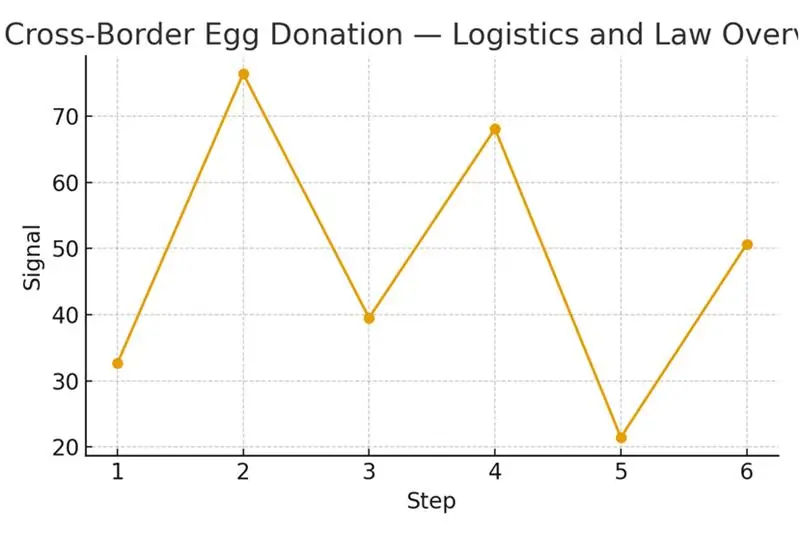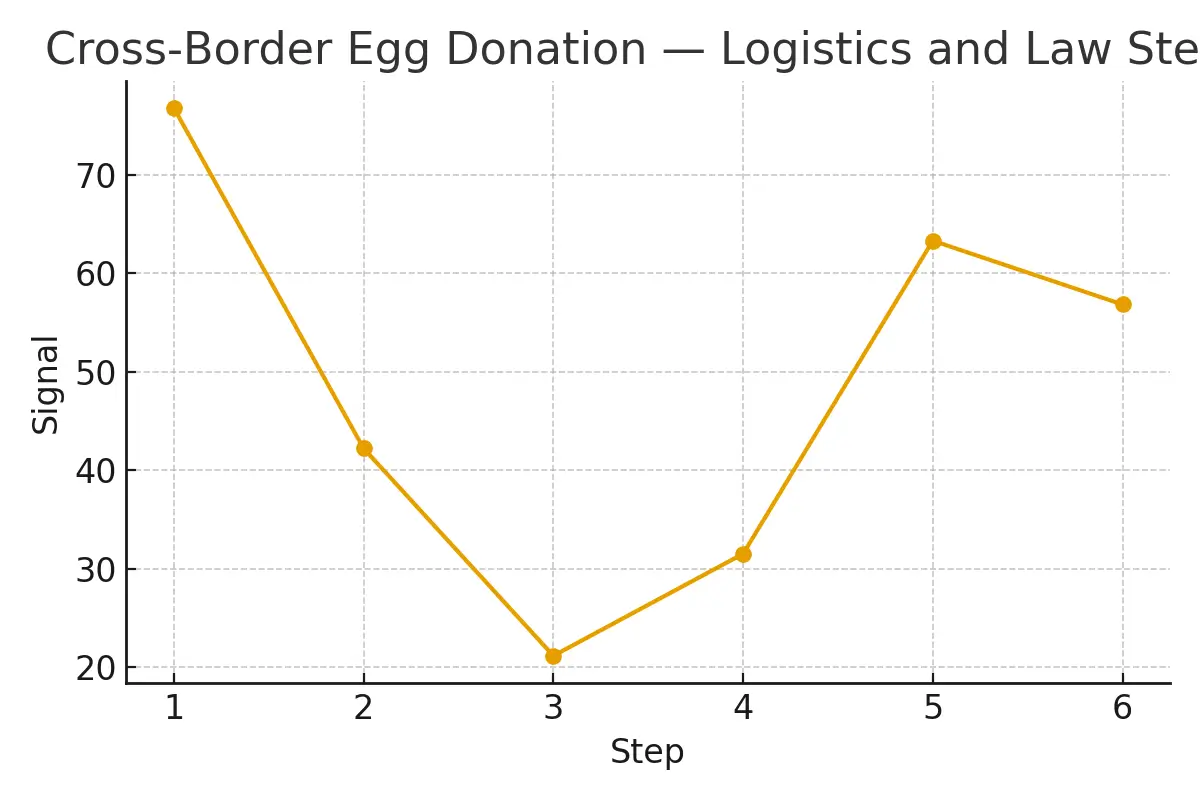
Cross-border egg donation has become a practical option for hopeful parents seeking reliable donor availability, predictable timelines, and clear legal structures. This pathway is especially relevant when local donor shortages, restrictive regulations, or elevated costs create unnecessary barriers. In this comprehensive guide, we explore cross-border egg donation — logistics and law within the Egg Donation 101 pathway, giving you clarity on timing, planning, budgeting, and decision-making so that every step feels simple, humane, and predictable.
You will learn who benefits most, how to evaluate clinics across borders, what legal protections to confirm, and which outcome drivers you can control. You’ll also find patient stories, expert insights, cost breakdowns, and a structured checklist to bring into your clinic consultations.
What Is Cross-Border Egg Donation?
Cross-border egg donation refers to undergoing part or all of the egg-donor process in another country. This can involve:
- Selecting a donor abroad
- Completing retrieval abroad while doing monitoring locally
- Shipping frozen eggs or embryos between clinics
- Coordinating legal documentation across jurisdictions
It sits within the Egg Donation 101 pathway as a branch for patients needing greater donor availability, clearer legal parentage rules, or reduced financial burden.
Many intended parents choose this option because:
- Local donor pools are limited
- Local laws restrict donor anonymity or compensation
- Wait times are long
- Costs are significantly lower overseas
- They seek donors matching specific traits or backgrounds
Cross-border care is common, safe when structured well, and increasingly supported by specialized fertility logistics companies.
Where Cross-Border Care Fits in the Fertility Journey
Before patients consider traveling for donor care, they typically complete:
- Diagnostic testing
- Consults with a reproductive endocrinologist
- A decision regarding egg vs embryo donation
- A review of donor availability and waitlists
- A cost assessment
If local options feel unpredictable, expensive, or legally restrictive, cross-border care becomes a next-step pathway that preserves momentum and clarity.
Cross-border egg donation is not a shortcut — it is a structured alternative pathway for those needing more predictability.
Eligibility Signals — Who Benefits Most?
Several patient profiles benefit from a cross-border approach. Key signals include:
A) Limited Donor Options Locally
If waitlists exceed 3–6 months, or donor availability does not match intended parents’ preferences, cross-border programs can offer faster access.
B) Legal Restrictions
Patients in jurisdictions with:
- Mandatory donor identity release
- Strict compensation caps
- Limits on embryo creation
- Restrictions on genetic testing (PGT)
C) Cost Sensitivity
Countries like Spain, Greece, Czech Republic, Mexico, and Cyprus offer lower pricing with high-quality care, helping patients allocate budget toward genetic testing or multiple cycles.
D) LGBTQ+ or Single Parents
Some countries offer clearer protections for:
- Same-sex couples
- Single intended parents
- Non-gestational parents
E) Prior IVF or Donor Failures
Patients needing more embryos, more consistent donor cycles, or high-matching precision benefit from larger donor pools internationally.
When to Pause or Escalate
- If basic diagnostics are incomplete
- If male-factor issues remain untreated
- If uterine factors are unresolved
- If travel introduces risk in early pregnancy (e.g., Zika-risk regions)
Step-by-Step Process With Timing Checkpoints
A predictable timeline keeps stress low. Below is a standard cross-border donor cycle roadmap.
Step 1: Consult + Case Review (Week 0–2)
- Review your medical history
- Determine donor preferences
- Identify country options and legal frameworks
- Confirm cost ranges
Checkpoint: Ensure clinic provides a written legal and logistics summary.
Step 2: Donor Selection (Week 2–6)
- Choose based on phenotype, medical history, availability, and anonymity rules.
- Checkpoint: Request donor cycle history and success data if available.
Step 3: Legal Agreements (Week 3–8)
Cross-border agreements include:
- Donor consent forms
- Intended parent agreements
- Parentage rights documentation
- Embryo program shipping permissions
- Clinic-to-clinic transfer letters
Checkpoint: Ensure your parentage is recognized in both countries.
Step 4: Medical Screening + Baseline Labs (Week 4–10)
You will complete your recipient workup:
- Hormones
- Infectious disease tests
- Uterine cavity evaluation
- Partner semen evaluation
Checkpoint: Make sure results are sent securely to the international clinic.
Step 5: Cycle Coordination (Week 8–12)
Two main approaches:
- Synchronized fresh cycle
- Frozen donor eggs (more predictable)
Checkpoint: Confirm medication start date, travel dates, and monitoring locations.
Step 6: Retrieval + Fertilization (Travel Week)
- If fresh, you travel.
- If frozen, eggs are thawed and fertilized locally.
Checkpoint: Get a same-day report on maturity, fertilization, and projected embryo development.
Step 7: Embryo Culture + PGT (Days 3–7)
- Embryos grow to the blastocyst stage.
- PGT is optional but often clarifies embryo competency early.
Checkpoint: Request daily lab updates.
Step 8: Embryo Transfer or Freeze-All (Week 12–16)
- Most cross-border cycles use frozen embryo transfer for scheduling flexibility.
- Checkpoint: Plan return travel or local FET depending on your clinic setup.
Step 9: Pregnancy Testing + Follow-Up
- Local monitoring occurs at home with your preferred OB-GYN or RE.
- Checkpoint: Ensure the clinic provides a follow-up care plan.
Pros and Cons of Cross-Border Egg Donation
Pros
- Larger donor pools
- Shorter wait times
- Lower cost per cycle
- Access to anonymous or identifiable donors, depending on preferences
- Legal clarity for LGBTQ+ and single parents
- High-quality clinics with strong IVF success data
Cons
- Travel logistics
- Visa considerations
- Variable laws on parentage
- Potential delays in transporting embryos
- Need for careful coordination between two clinics
Cross-border cycles work best with clinics that offer fully managed logistics, meaning they coordinate transport, documents, and monitoring locations.
Cost Breakdown — Line-Item Examples
Cross-border donor cycles can vary significantly by country, but predictable ranges help with planning.
A Typical Cross-Border Donor Cycle Budget
| Line Item | Estimated Cost |
| Donor compensation | $3,000–$8,000 |
| Stimulation medications | $1,200–$3,500 |
| Donor agency fee | $1,000–$4,000 |
| Retrieval procedure | $1,500–$4,000 |
| IVF + ICSI lab fees | $3,000–$8,000 |
| PGT testing (optional) | $2,000–$6,000 |
| Embryo freezing | $500–$1,200 |
| Embryo storage | $300–$600/year |
| Recipient medications | $300–$1,200 |
| Travel & lodging | $800–$2,500 |
Average total range: $12,000–$30,000
Local donor cycles can exceed $50,000, making cross-border care dramatically more accessible.
Outcome Drivers — What You Control vs. What You Monitor
What You Control
- Selecting a clinic with strong lab success rates
- Choosing donors with proven cycle histories
- Ensuring male-factor optimization (motility, morphology, DNA fragmentation)
- Maintaining simple, predictable schedules
- Prioritizing clinics with transparent pricing
- Using evidence-based add-ons only
What You Monitor
- Egg maturity rates
- Fertilization rates
- Embryo growth pace
- PGT results
- Endometrial thickness for transfer
Questions to Ask Your Cross-Border Clinic
Before signing with any program, ask:
- What legal protections guarantee our parentage?
- Is donor anonymity guaranteed or optional?
- What is the expected embryo yield for donors of this type?
- Do you ship embryos to our home country if needed?
- How do you coordinate monitoring with my local doctor?
- What percentage of donor cycles result in blastocysts?
- What is your emergency backup plan for travel delays?
Expert Insight
“Protect timing and keep plans simple—quality improves when noise goes down.” — Clinical Team
Patient Case Study
A couple entered care after months of inconclusive testing and unpredictable local donor availability. Costs felt overwhelming, and uncertainty stalled their timeline.
By shifting to a structured cross-border program:
- They selected a donor within four weeks
- Legal steps were completed in a single review
- Travel was planned around their jobs
- Embryos were created and tested with transparent pricing
- Their clinic simplified communication between countries
Testimonials
“The steps finally made sense.” — A.&J., Manhattan
“Costs were clear; no surprise bills.” — L., Hoboken
“Nurses replied fast with practical coaching.” — K.&V., Queens
Frequently Asked Questions (FAQs)
Q: Is this medical advice?
Ans : No. This information is educational and should be used to guide conversations with your clinic.
Q: How many cycles should I plan?
Ans : It’s best to think in ranges rather than a single number. Fertility outcomes are cumulative, and planning for more than one cycle improves.
Q: What drives cost most?
Ans : The biggest cost factors include medications, genetic testing decisions, anesthesia and procedure fees, and the total number of cycles.
Additional Insights to Improve Success
Genetic Testing Decisions
Genetic testing improves clarity on embryo competency and helps shape expectations about how many embryos are likely to reach transfer.
Diagnostic Accuracy Thresholds
Accurate uterine diagnostics reduce implantation failure and minimize unnecessary add-ons.
Insemination vs. ICSI
While often routine, ICSI rarely changes overall predictability unless male-factor issues exist.
Male-Factor Optimization
Addressing DNA fragmentation, varicocele, or morphology issues improves blastocyst yield and avoids preventable cycle delays.
Frozen Embryo Transfer Strategy
A freeze-all strategy allows precise scheduling and avoids the risk of cycle cancellation.
Next Steps with Surrogacy4All
If you’re ready to move forward, Surrogacy4All offers:
- Free 15-minute nurse consult (212) 661-7673
- Upload your labs for a second opinion
- Customized cost breakdown for your case
These tools simplify planning and ensure transparency every step of the way.
Conclusion
Cross-border egg donation offers intended parents more options, clearer legal protections, and more predictable timelines when local barriers slow progress. By understanding logistics and law, reviewing eligibility signals, coordinating step-by-step timing, and confirming outcome drivers, patients can navigate the process with confidence. Whether you need larger donor pools, affordability, or legal clarity, cross-border egg donation is a practical pathway that aligns care with your values, timeline, and family-building goals.

Dr. Kulsoom Baloch
Dr. Kulsoom Baloch is a dedicated donor coordinator at Egg Donors, leveraging her extensive background in medicine and public health. She holds an MBBS from Ziauddin University, Pakistan, and an MPH from Hofstra University, New York. With three years of clinical experience at prominent hospitals in Karachi, Pakistan, Dr. Baloch has honed her skills in patient care and medical research.





